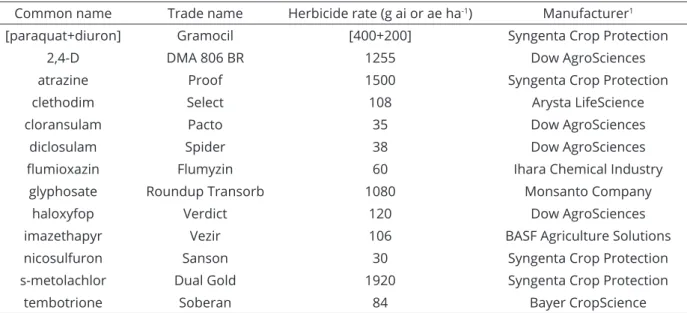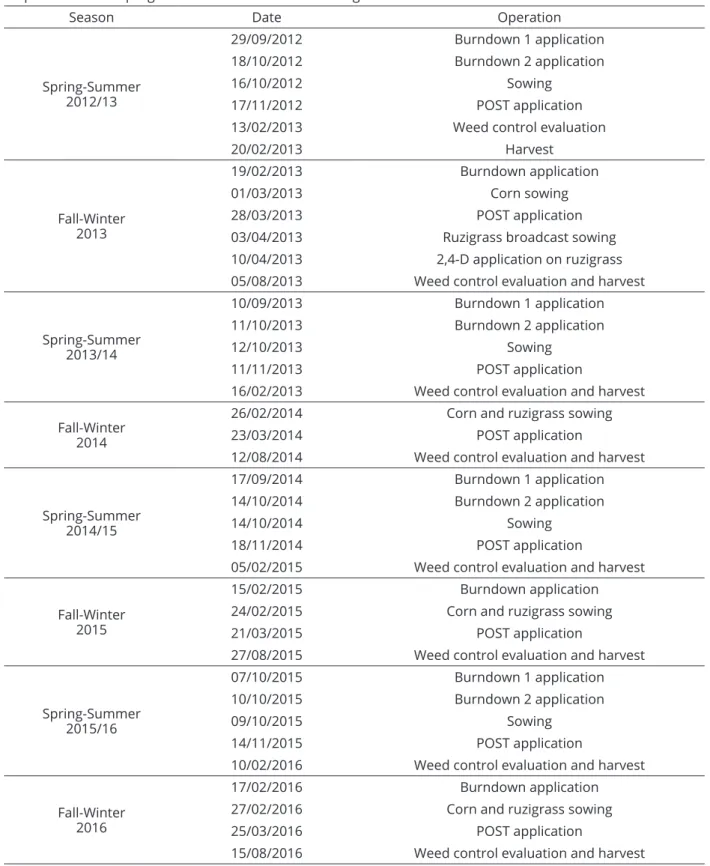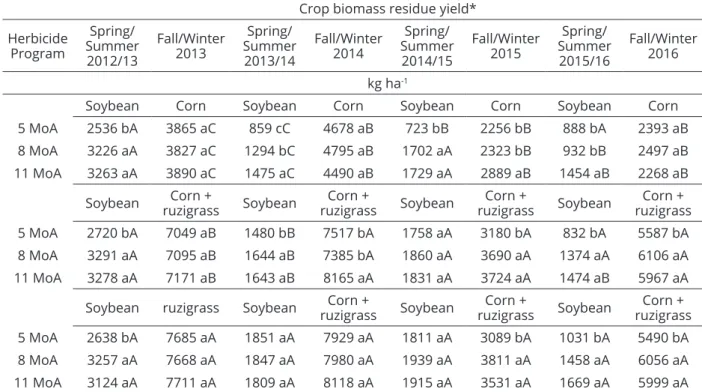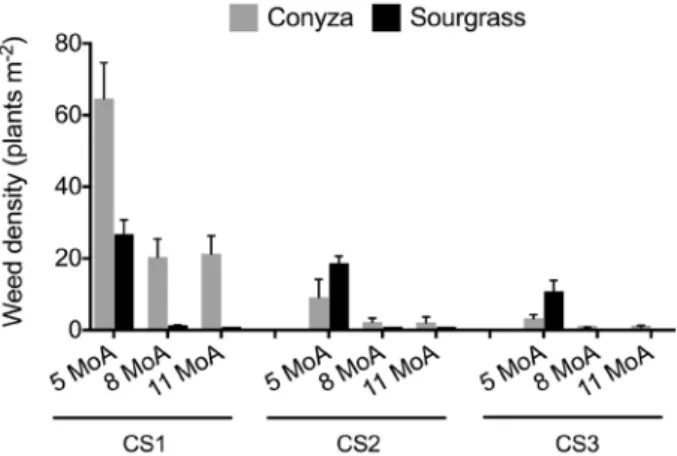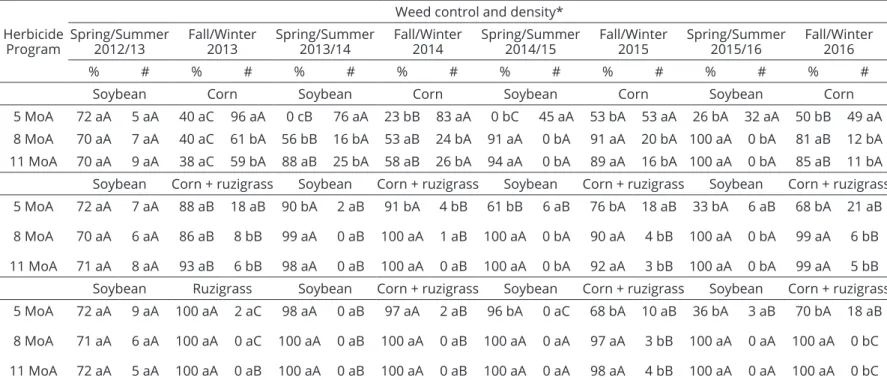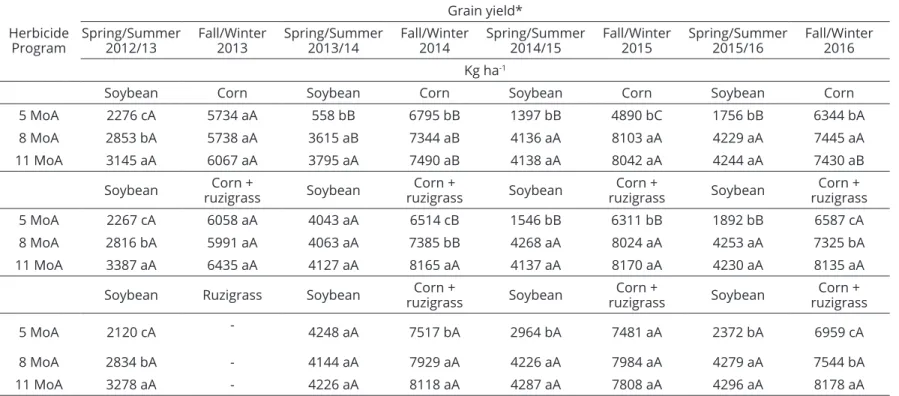2018 | Lavras | Editora UFLA | www.editora.ufla.br | www.scielo.br/cagro
http://dx.doi.org/10.1590/1413-70542018424017918
Managing glyphosate-resistant weeds with cover crop associated
with herbicide rotation and mixture
Manejando plantas daninhas resistentes ao glyphosate com cultura de cobertura associada a rotação e mistura de herbicidas
Aroldo Marochi1, Antonio Ferreira2, Hudson Kagueyama Takano3*, Rubem Silvério Oliveira Junior4, Ramiro Fernando Lopez Ovejero2
1AgroMarochi, Ponta Grossa, PR, Brasil 2Monsato, São Paulo, SP, Brasil
3Colorado State University, Fort Collins, CO, United States of America 4Universidade Estadual de Maringá/UEM, Maringá, PR, Brasil *Corresponding author: hudsontakano@gmail.com Received in July 4, 2018 and approved in August 20, 2018
ABSTRACT
Herbicide resistance has become a major concern for agricultural systems, and integrating weed management practices seem to be the
most promise way for its mitigation. The effects of cropping systems including ruzigrass (Urochloa ruziziensis) associated with herbicide
rotation programs were evaluated for the management of glyphosate resistant conyza (Conyza sumatrensis) and sourgrass (Digitaria insularis)in soybean and corn production systems. A 3x3 factorial was evaluated in four consecutive soybean (spring-summer) and corn
(fall-winter) double cropping seasons. Factor A consisted of three combinations of cropping systems in the fall-winter: corn, corn plus ruzigrass, and ruzigrass alone. Factor B was based on increasing levels of diversity in herbicide mode of action over the four-year period (5, 8, and 11 MoAs). The results indicate that using ruzigrass significantly increased soil coverage by cover crop residues. In general, the cover crop was more efficient for conyza than for sourgrass control, whereas herbicide programs provided greater control on sourgrass than on conyza. Besides the weed suppression effect, the accumulation of ruzigrass biomass on the soil surface during the fall-winter also improved yield of soybean in the spring-summer. The integration of ruzigrass as a cover crop and the use of herbicide programs with multiple modes of action can provide efficient control of glyphosate-resistant conyza and sourgrass. The use of only one of these strategies was not effective in most cases, especially for the long term.
Index terms: Digitaria insularis; Conyza sumatrensis; integrated weed management; Urochloa ruziziensis; herbicide resistance.
RESUMO
A resistência a herbicidas tem se tornado um dos principais problemas que os produtores têm enfrentado, e as estratégias de manejo integrado de plantas daninhas são as mais importantes ferramentas para a sua mitigação. O objetivo deste trabalho foi investigar o efeito
do cultivo de braquiária (Urochloa ruziziensis) associado a diferentes programas de rotação de herbicidas no manejo de buva (Conyza sumatrensis) e capim-amargoso (Digitaria insularis) resistentes ao glyphosate no sistema de produção de soja e milho. Um fatorial 3x3 foi avaliado durante quatro safras consecutivas de soja no verão e milho no inverno. O Fator A foi constituído de diferentes sistemas de manejo de inverno: milho solteiro, milho integrado com braquiária e braquiária solteira. O Fator foi baseado em programas de rotação de herbicidas com diferentes níveis de diversidade em mecanismos de ação ao longo das quatro safras. O cultivo de braquiária no inverno
incrementou significativamente a biomassa residual no solo. Essa cobertura do solo foi mais eficiente para controlar buva do que
capim-amargoso, embora ambas plantas daninhas foram suprimidas pela cultura de cobertura. O uso de programas com maior rotação de
mecanismos de ação de herbicidas foi mais eficiente para controlar capim-amargoso do que buva. O uso isolado de cultura de cobertura
ou de rotação de herbicidas não foi efetivo para o manejo de buva e amargoso. No entanto, integrando essas duas opções de manejo, foi possível controlar efetivamente ambas as espécies resistentes ao glyphosate e consequentemente aumentar a produtividade das culturas. Termos para indexação: Digitaria insularis; Conyza sumatrensis; manejo integrado de plantas daninhas; Urochloa ruziziensis; resistência a herbicidas.
INTRODUCTION
In the last decades, Brazil has become one of the largest grain producers in the world (USDA, 2017). This increase in production is mainly due to the use of crop varieties with high yield potential combined with
Ciência e Agrotecnologia, 42(4):381-394, Jul/Aug. 2018
382 MAROCHI, A. et al.
for a total production of 199.5 billion kg of these two crops (USDA, 2017).
In the modern Brazilian agriculture, there is a consensus to intensify the production model to obtain higher yields and profitability via crop rotations and best management practices. One example is a production system that alternates soybean with corn, enabling the production of two crops per year in most of the country’s grain-producing areas. This cropping system is commonly used in areas such as Paraná, Mato Grosso do Sul, Goiás, and Mato Grosso (Siqueira Neto et al., 2010). In this system, soybean is generally planted in September-November (spring-summer), while corn is planted immediately after soybean harvest between January and March (fall-winter). Corn residue degrades quickly, especially in areas with predominant high temperatures such as the Central-West region of Brazil. This significantly impacts the influence of crop residue as a tool for suppressing weed emergence (Davis, 2010).
The main glyphosate-resistant (GR) weeds in Brazil include sourgrass (Digitaria insularis), a perennial species, and the complex of Conyza species (Conyza canadensis, C. bonariensis, and C. sumatrensis - herein referred as conyza), all annual species. These weed species are of great importance to the soybean-corn production system and are found throughout most regions of the country (Lopez Ovejero et al., 2017; Santos et al., 2014). In the case of soybean, the potential yield loss due to weed interference can be as much as 64% for sourgrass and 55% for conyza (Oliveira Neto et al., 2010; Gemelli et al., 2012). The complex formed by the conyza species is estimated to extend to 10.6 million ha. Similarly, the infested area with sourgrass is estimated to be 8.2 million ha (Lopez Ovejero et al., 2017). In this grass species, biotypes that are also resistant to ACCase inhibitors have been identified (Heap, 2018). Regarding to conyza, biotypes that are resistant to ALS inhibitors, photosystem I inhibitors, and PPO inhibitors have already been reported in Brazil (Santos et al., 2014; Heap, 2018). Thus, these species commonly infest the same areas concurrently, making their management more complex. This is mainly because the efficacy of available strategies, most of them including tank mixtures, is affected by incompatibility among product formulations and antagonism between herbicides.
For a consistent management of these weeds, considering cost-effective long-term production systems, including management tools such as cover crops and herbicide rotation (Chikowo et al., 2009), is crucial. Ruzigrass (Urochloa ruziziensis, Germ & Evrard) is a
tropical grass that is used for animal feed, but also has been used as a cover crop in winter, as a single crop, or intercropped with corn as second crop (Oliveira Junior et al., 2014). Corn cultivation intercropped with ruzigrass, when properly managed, provides physicochemical benefits and covers the soil with biomass, contributing significantly to weed suppression without interfering with corn yield (Baldé et al., 2011). In this cropping system, ruzigrass is managed as an annual plant and grown with the purpose of providing soil coverage during the period between corn harvest and soybean planting (Borghi et al., 2008). Using ruzigrass as a cover crop usually provides up to 3.5 ton ha-1 of dry mass after burndown prior to sowing
(Oliveira Junior et al., 2014). Ruzigrass can also suppress weed growth when grown alone or when intercropped with corn. In addition, weed suppression provided by this grass is not limited to the biomass physical effect but can also due to allelopathic compounds with suppressive effect on weed emergence that have been identified (Paiva-Foletto et al., 2012).
Several factors contribute to the selection of herbicide-resistant weeds; however, using one herbicide as a single weed management tool is the main factor for selection pressure of resistant biotypes (Norsworthy et al., 2012). In turn, herbicide rotations or combinations with different mechanisms of action, as well as using cover crops, whether cultivated alone or intercropped, are essential tools to reduce selection pressure for resistant biotypes (Beckie, 2011; Norsworthy et al., 2012).
In this context, the hypothesis of this study is that within a profitable crop-rotation system, ruzigrass cultivation as a cover crop, combined with different herbicide strategies (mixture and rotation) is effective for GR conyza and sourgrass management. Few studies have quantified the benefits of ruzigrass and diverse herbicide programs in managing resistance. Therefore, the objective of this research was to evaluate the effects of different ruzigrass cultivation systems in combination with different herbicide rotation and tank mixtures on conyza and sourgrass management in a soybean/corn production system in Brazil.
MATERIAL AND METHODS
conyza and sourgrass management. Glyphosate resistance in conyza and sourgrass in this field was confirmed in our previous research, in which both species were not controlled with the glyphosate discriminatory rate of 960 g ae ha-1 (Lopez Ovejero et al., 2017).
The experimental area was under a no-tillage system for the past 14 years, with successive soybean (spring/summer) followed by corn (fall/winter) cultivation in the previous seven years. Roundup Ready® soybean
varieties had been used in this area for the last 10 years. The soil from the experimental area was a sandy-clay loam with pH 6 and 3.1% organic matter.
Plots dimensions were 20 m long by 12 m wide. The experimental design was randomized complete block with three replications. Treatments were arranged in a 3 x 3 factorial. The Factor A was consisted of three different herbicide programs, whereas Factor B was consisted of three different cropping systems (CS). The herbicide programs (Factor A) contained increasing number of different mechanisms of action used over the four years of study: 5 MoA, 8 MoA, and 11 MoA (Table 1; Table 2). The cropping systems (Factor B) encompassed corn alone (CS1), corn intercropped with ruzigrass (CS2) and ruzigrass alone (CS3) only in the first fall/ winter (Table 3). For the second, third and fourth fall/ winter seasons, corn alone was planted in CS1 and corn
intercropped with ruzigrass was cultivated in CS2 and CS3. Ruzigrass seeding was broadcast after POST** application at 20 kg seeds ha-1 for all cropping systems. The
cultural value for the ruzigrass seeds was 76%. Soybean was always the crop cultivated in the spring/summer for all treatments. For all years the soybean variety and corn hybrid were BMX Vmax and DKB330 Pro, respectively.
Before the experiments were established, conyza density was 58.2 plants m-2 with 2- to 35-cm-height stage,
whereas sourgrass density was 16.7 plants m-2, with
plants ranging from five tillers to flowering. All herbicide applications were performed using a CO2-pressurized backpack sprayer with 2 m-boom equipped with XR 11002 flat fan nozzles, spaced at 0.50 m calibrated to deliver a carrier volume of 200 L ha-1 The dates for planting,
spraying, and evaluation are presented in Table 4. Weed control was evaluated at the end of each cropping cycle using visual scale of 0-100%, where 0% meant no symptoms and 100% represented plant death. In addition, weeds were counted on three random samplings of 1 m2 per plot. Dry biomass production was
also evaluated immediately after each harvest, by sampling occurring three 1 m2 points per plot. To evaluate crop’s
yield, plants were harvested manually; these plants were then threshed, grains were weighed, and moisture was
Table 1: Herbicide common and trade names and respective rates used in all experiments.
Common name Trade name Herbicide rate (g ai or ae ha-1) Manufacturer1
[paraquat+diuron] Gramocil [400+200] Syngenta Crop Protection
2,4-D DMA 806 BR 1255 Dow AgroSciences
atrazine Proof 1500 Syngenta Crop Protection
clethodim Select 108 Arysta LifeScience
cloransulam Pacto 35 Dow AgroSciences
diclosulam Spider 38 Dow AgroSciences
flumioxazin Flumyzin 60 Ihara Chemical Industry
glyphosate Roundup Transorb 1080 Monsanto Company haloxyfop Verdict 120 Dow AgroSciences
imazethapyr Vezir 106 BASF Agriculture Solutions
nicosulfuron Sanson 30 Syngenta Crop Protection
s-metolachlor Dual Gold 1920 Syngenta Crop Protection
tembotrione Soberan 84 Bayer CropScience
1Syngenta Crop Protection, Greensboro, NC; http://www.syngentacropprotection.coma AG; Dow AgroSciences, Indianapolis,
Ciência e Agrotecnologia, 42(4):381-394, Jul/Aug. 2018
384 MAROCHI, A. et al.
Table 2: Herbicide programs (# MoA) across a 4-year study with cover crop and herbicide rotation and mixture
for weed resistance management.
Season Application Herbicide Programs
5 MoA 8 MoA 11 MoA
Spring-Summer
2012/13
Burndown 1 gly+2,4D+cle gly+2,4D+cle gly+2,4D+cle Burndown 2 [par+diu] [par+diu]+s-met [par+diu]+ima
POST gly gly+cle gly+cle
Fall-Winter
2013
Burndown gly+cle gly+cle gly+cle
POST** atr atr atr+2,4D
Spring-Summer
2013/14
Burndown 1 gly+2,4D+cle gly+2,4D+cle gly+2,4D+cle Burndown 2 par [par+diu]+dic [par+diu]+s-met
POST gly gly+cle gly+cle
Fall-Winter
2014 POST** gly+atr gly+atr glu+atr
Spring-Summer 2014/15
Burndown 1 gly+2,4D+cle gly+2,4D+cle gly+2,4D+cle Burndown 2 par glu+s-met [par+diu]+flu
POST gly gly+cle gly+cle
Fall-Winter 2015
Burndown gly+cle gly+cle gly+cle POST** gly+atr gly+atr nic+atr
Spring-Summer 2015/16
Burndown 1 gly+2,4D gly+2,4D+hal gly+2,4D+cle Burndown 2 par [par+diu]+flu glu+flu+tri
POST gly+hal gly+cle+clo gly+hal+clo
Fall-Winter 2016
Burndown gly gly+hal gly+cle
POST** gly+atr nic+atr tem+atr
*gly = glyphosate; cle = clethodim; par = paraquat; diu = diuron; ima = imazethapyr; 2,4D = 2,4-D; s-met = s-metolachlor; atr = atrazine; tem = tembotrione; tri = trifluralin; dic = diclosulam; flu = flumioxazin; nic = nicosulfuron; clo = cloransulam; hal = haloxyfop. **POST=Post-emergence in corn but not for ruzigrass.
Table 3: Crop systems (CS) across a 4-year study with cover crop and herbicide programs for weed resistance
management.
Season Cropping System
CS1* CS2 CS3
Spring-Summer 2012/13 Soybean Soybean Soybean
Fall-Winter 2013 Corn Corn + ruzigrass Ruzigrass
Spring-Summer 2013/14 Soybean Soybean Soybean
Fall-Winter 2014 Corn Corn + ruzigrass Corn + ruzigrass
Spring-Summer 2014/15 Soybean Soybean Soybean
Fall-Winter 2015 Corn Corn + ruzigrass Corn + ruzigrass
Spring-Summer 2015/16 Soybean Soybean Soybean
Fall-Winter 2016 Corn Corn + ruzigrass Corn + ruzigrass
Table 4: Calendar of applications, sowing dates, evaluations and crop harvesting across a 4-year study with cover
crop and herbicide programs for weed resistance management.
Season Date Operation
Spring-Summer
2012/13
29/09/2012 Burndown 1 application
18/10/2012 Burndown 2 application
16/10/2012 Sowing
17/11/2012 POST application 13/02/2013 Weed control evaluation
20/02/2013 Harvest
Fall-Winter
2013
19/02/2013 Burndown application 01/03/2013 Corn sowing
28/03/2013 POST application
03/04/2013 Ruzigrass broadcast sowing 10/04/2013 2,4-D application on ruzigrass
05/08/2013 Weed control evaluation and harvest
Spring-Summer
2013/14
10/09/2013 Burndown 1 application 11/10/2013 Burndown 2 application
12/10/2013 Sowing
11/11/2013 POST application
16/02/2013 Weed control evaluation and harvest
Fall-Winter
2014
26/02/2014 Corn and ruzigrass sowing
23/03/2014 POST application
12/08/2014 Weed control evaluation and harvest
Spring-Summer 2014/15
17/09/2014 Burndown 1 application 14/10/2014 Burndown 2 application
14/10/2014 Sowing
18/11/2014 POST application
05/02/2015 Weed control evaluation and harvest
Fall-Winter 2015
15/02/2015 Burndown application
24/02/2015 Corn and ruzigrass sowing
21/03/2015 POST application
27/08/2015 Weed control evaluation and harvest
Spring-Summer 2015/16
07/10/2015 Burndown 1 application
10/10/2015 Burndown 2 application
09/10/2015 Sowing
14/11/2015 POST application
10/02/2016 Weed control evaluation and harvest
Fall-Winter 2016
17/02/2016 Burndown application
27/02/2016 Corn and ruzigrass sowing
25/03/2016 POST application
Ciência e Agrotecnologia, 42(4):381-394, Jul/Aug. 2018
386 MAROCHI, A. et al.
adjusted to 13%. Temperatures and rainfall across the period of the experiments are presented in Figure 1.
The statistical analysis was performed using the software Sisvar (UFLA, Lavras, MG, Brazil) (Ferreira 2011). Data passed for variance homogeneity (Levene) and normality (Shapiro-Wilk) tests. All collected data were analyzed with ANOVA to test for significant main effects and interactions. Cropping system and herbicide treatment were considered fixed effect, whereas replication and year were treated as random effects. Where the ANOVA indicated significant differences, means were separated with Fisher’s protected LSD at a = 0.05. Means of the isolated main effects (cropping system and herbicide programs) over time were also represented using nonparametric statistics.
RESULTS AND DISCUSSION
The analysis of variance showed significant differences among treatments for all variables, except for conyza control in the first soybean cycle (2012/13). These results were expected because the herbicides used in this first soybean cycle were the same for all treatments. The interaction between cropping systems and herbicide programs was also significant for most of the years and variables.
In fall-winter 2013, biomass yield in treatments with ruzigrasswas 3,800 kg ha-1 greater than in treatments
without cover crop, which corresponds to two times the
residual biomass compared to the preceding crop (Table 5). Intercropping ruzigrass and corn produced 600 kg ha-1 less
biomass than ruzigrass alone. In general, for subsequent crops, treatments with 8 or 11 different modes of action as well as in those with ruzigrassalone or intercropped with corn in the winter, biomass production was similar or higher than when corn was planted alone or when no herbicide diversity was employed. Similar biomass yield was observed in other research for corn intercropped with ruzigrass, and this amount of cover crop residual provided more than 90% suppression on weed germination (Borghi et al., 2008).
For sourgrass control, treatments with ruzigrass in the fall-winter and with herbicide programs that contained 8 and 11 MoA provided the greatest control over all crops (Table 6). The cropping system with low herbicide diversity (5 MoA) exhibited high levels of control until 2013/14 season; however, from 2014 forward, the control observed with this treatment was not consistent, especially through soybean cultivation. The use of corn intercropped with ruzigrass (CS2) in fall/winter, combined with greater herbicide diversity (8 MoA and 11 MoA), also provided good control throughout all crops. Nevertheless, ruzigrass alone (CS3) provided higher weed suppression than when intercropped with corn. Treatments without ruzigrass in the fall/winter were not efficient for sourgrass control, especially in 2014 and 2016. In agreement with this research, other studies with several weed species have also shown that the use of cover crops is not only effective in suppressing Figure 1: Temperature (T ºC max, T ºC min) and rainfall (mm) data across a 4-year study with crop and herbicide
Table 5: Crop biomass residue yield (kg ha-1) across a 4-year study with crop and herbicide programs for weed
resistance management.
Crop biomass residue yield*
Herbicide Program
Spring/ Summer 2012/13
Fall/Winter
2013
Spring/ Summer 2013/14
Fall/Winter
2014
Spring/ Summer
2014/15
Fall/Winter 2015
Spring/ Summer
2015/16
Fall/Winter 2016
kg ha-1
Soybean Corn Soybean Corn Soybean Corn Soybean Corn
5 MoA 2536 bA 3865 aC 859 cC 4678 aB 723 bB 2256 bB 888 bA 2393 aB
8 MoA 3226 aA 3827 aC 1294 bC 4795 aB 1702 aA 2323 bB 932 bB 2497 aB 11 MoA 3263 aA 3890 aC 1475 aC 4490 aB 1729 aA 2889 aB 1454 aB 2268 aB
Soybean ruzigrassCorn + Soybean ruzigrassCorn + Soybean ruzigrassCorn + Soybean ruzigrassCorn +
5 MoA 2720 bA 7049 aB 1480 bB 7517 bA 1758 aA 3180 bA 832 bA 5587 bA
8 MoA 3291 aA 7095 aB 1644 aB 7385 bA 1860 aA 3690 aA 1374 aA 6106 aA 11 MoA 3278 aA 7171 aB 1643 aB 8165 aA 1831 aA 3724 aA 1474 aB 5967 aA
Soybean ruzigrass Soybean ruzigrassCorn + Soybean ruzigrassCorn + Soybean ruzigrassCorn +
5 MoA 2638 bA 7685 aA 1851 aA 7929 aA 1811 aA 3089 bA 1031 bA 5490 bA
8 MoA 3257 aA 7668 aA 1847 aA 7980 aA 1939 aA 3811 aA 1458 aA 6056 aA 11 MoA 3124 aA 7711 aA 1809 aA 8118 aA 1915 aA 3531 aA 1669 aA 5999 aA
*Means followed by the same lowercase letters for herbicide program and uppercase letters for cropping system do not differ by Fisher’s LSD test (p<0.05).
weed emergence but also in reducing weed seed bank in the soil (Brennan; Smith, 2005; Peachey et al., 2002).
During the 4-year study, sourgrass infestation was lower in treatments with corn intercropped with ruzigrass and even lower for ruzigrass-alone treatments in the fall-winter, compared to the treatment with no herbicide diversity and without ruzigrass cultivation (Figure 2). However, the use of herbicide rotation and mixture associated with corn intercropped with ruzigrass and ruzigrass alone maintained sourgrass infestation at extremely low levels. Herbicide rotation and mixture by itself, without ruzigrass, was not effective controlling sourgrass. On the other hand, ruzigrass alone associated with higher herbicide diversity, provided 100% control on conyza and sourgrass, which demonstrates the suppression effect on weeds afforded by the formation of greater biomass amounts in these treatments (CS2 and CS3). Similar results were reported by Castagnara et al. (2011) who observed 50% suppression on conyza emergence when ruzigrass was planted at 22.5 kg ha-1. The weed
suppressor effect provided by ruzigrass biomass is beyond the physic soil coverage since natural compounds have
been identified in ruzigrass extracts with negative effect on weed germination (Paiva-Foletto et al., 2012).
Ciência e Agrotecnologia, 42(4):381-394, Jul/Aug. 2018 388
MAROCHI, A. et al.
Table 6: Control (%) and densities (#) of sourgrass (no of plants m-2) across a 4-year study with crop and herbicide program for weed resistance management.
Herbicide Program
Weed control and density* Spring/Summer
2012/13 Fall/Winter2013
Spring/Summer
2013/14 Fall/Winter2014
Spring/Summer
2014/15 Fall/Winter2015 Spring/Summer2015/16 Fall/Winter2016
% # % # % # % # % # % # % # % #
Soybean Corn Soybean Corn Soybean Corn Soybean Corn
5 MoA 12cA 12aA 73bB 7aA 0bC 17aA 0cB 13aA 0bC 28aA 25bC 34aA 0bA 59aA 20bC 37aA
8 MoA 70bA 3bA 96aA 0bA 95aA 0bA 66bB 4bA 99aA 0bA 91aA 0bA 100aA 0bA 88aA 1bA
11 MoA 80aA 1bA 98aA 0bA 100aA 0bA 81aB 0cA 99aA 0bA 91aA 0bA 99aA 0bA 89aA 1bA
Soybean Corn + ruzigrass Soybean Corn + ruzigrass Soybean Corn + ruzigrass Soybean Corn + ruzigrass
5 MoA 15cA 10aA 94aA 1aB 70bB 4aB 61bA 8aB 20bB 18aB 48bB 35aA 5bA 44aB 51bB 28aA
8 MoA 70bA 3bA 98aA 0aA 100aA 0bA 97aA 0bB 100aA 0bA 91aA 0bA 100aA 0bA 95aA 0bA
11 MoA 81aA 1bA 98aA 0aA 100aA 0bA 100aA 0bA 100aA 0bA 94aA 0bA 100aA 0bA 94aA 0bA
Soybean Ruzigrass Soybean Corn + ruzigrass Soybean Corn + ruzigrass Soybean Corn + ruzigrass
5 MoA 12cA 12aA 100aA 0aB 94aA 1aC 65bA 3aC 41bA 10aC 92aA 18aB 8bA 31aC 94aA 8aB
8 MoA 71bA 3bA 100aA 0aA 100aA 0aA 100aA 0bB 100aA 0bA 98aA 0bA 100aA 0bA 100aA 0bA
11 MoA 82aA 1bA 100aA 0aA 100aA 0aA 100aA 0bA 100aA 0bA 97aA 0bA 100aA 0bA 100aA 0bA
Figure 2: Average densities of sourgrass and conyza
across a 4-year study with crop and herbicide programs
with increasing number of MoAs for weed resistance management. CS1, CS2 and CS3: cropping system
with corn alone, corn intercropped with ruzigrass, and ruzigrass alone in the first fall/winter, respectively.
combined with cultivation of ruzigrass alone is the best option for managing this species (Figure 3). By contrast, herbicide rotation and mixture without ruzigrass in the fall/winter was also not sufficient for the effective control of this species. Greater conyza infestations were observed for treatments with no herbicide rotation and no use of ruzigrass in the fall/winter. In general, the use of ruzigrass as a cover crop was more effective in suppressing conyza than sourgrass. This is mainly because conyza emerges in colder months of the year (May-August), when ruzigrass is already established, whereas sourgrass can emerge throughout the year when soil moisture is present. Moreover, these species have different life cycles, as sourgrass is a perennial plant,
whereas conyza completes its cycle annually (Gemelli et al., 2013; Marochio et al., 2017).
When analyzing the effects of isolated factors (cropping system and herbicide programs), ruzigrass cultivation in the fall-winter, either alone or intercropped with corn, was extremely effective in controlling conyza (Figure 3). For sourgrass, the use of ruzigrass suppressed emergence of this weed, especially when the cover crop was grown alone. Herbicide diversity programs had a significant effect on management of these two weeds, especially sourgrass (Figure 4). Throughout the experimental period, treatments with herbicide rotation led to lower infestations than treatments with low herbicide diversity. Furthermore, at the end of the experiment, the
infestation of both species was almost zero in treatments with herbicide rotation, suggesting that this is an effective tool for weed management. In accordance to these findings, resistance frequency models show that herbicide mixing and rotation of herbicides with different mechanisms of action are effective in delaying herbicide resistance (HR) evolution (Powles et al., 1997; Diggle; Neve; Smith, 2003; Beckie, 2006).
In the first soybean year (2012/13), grain yield was greater for treatments with the highest levels of herbicide diversity programs (11 MoA) (Table 8). No difference was observed among treatments in the fall-winter of 2013, but higher yields were observed in 2013/14 soybean crop for treatments that ruzigrass was cultivated in fall-winter. Moreover, from that crop onward, greater yields were observed for treatments with higher levels of herbicide rotation and mixture, associated with ruzigrass cultivation in the fall-winter, especially due to better weed control afforded by herbicides and by biomass formation. Corn yield was not affected by interference or competition with the intercropping ruzigrass in any year. In addition to the effects of biomass on weed emergence, the biomass accumulation on the soil surface have additional benefits such as lower evapotranspiration, greater water availability, and nutrient recycling. These benefits have been proven to be beneficial for yield improvement in corn and soybean (Baschea et al., 2016).
Ciência e Agrotecnologia, 42(4):381-394, Jul/Aug. 2018 390
MAROCHI, A. et al.
Table 7: Control (%) and densities (#) of conyza (no of plants m-2) across a 4-year study with crop and herbicide program for weed resistance management.
Herbicide Program
Weed control and density* Spring/Summer
2012/13 Fall/Winter2013
Spring/Summer
2013/14 Fall/Winter2014
Spring/Summer
2014/15 Fall/Winter2015 Spring/Summer2015/16 Fall/Winter2016
% # % # % # % # % # % # % # % #
Soybean Corn Soybean Corn Soybean Corn Soybean Corn
5 MoA 72 aA 5 aA 40 aC 96 aA 0 cB 76 aA 23 bB 83 aA 0 bC 45 aA 53 bA 53 aA 26 bA 32 aA 50 bB 49 aA
8 MoA 70 aA 7 aA 40 aC 61 bA 56 bB 16 bA 53 aB 24 bA 91 aA 0 bA 91 aA 20 bA 100 aA 0 bA 81 aB 12 bA
11 MoA 70 aA 9 aA 38 aC 59 bA 88 aB 25 bA 58 aB 26 bA 94 aA 0 bA 89 aA 16 bA 100 aA 0 bA 85 aB 11 bA
Soybean Corn + ruzigrass Soybean Corn + ruzigrass Soybean Corn + ruzigrass Soybean Corn + ruzigrass
5 MoA 72 aA 7 aA 88 aB 18 aB 90 bA 2 aB 91 bA 4 bB 61 bB 6 aB 76 bA 18 aB 33 bA 6 aB 68 bA 21 aB
8 MoA 70 aA 6 aA 86 aB 8 bB 99 aA 0 aB 100 aA 1 aB 100 aA 0 bA 90 aA 4 bB 100 aA 0 bA 99 aA 6 bB
11 MoA 71 aA 8 aA 93 aB 6 bB 98 aA 0 aB 100 aA 0 aB 100 aA 0 bA 92 aA 3 bB 100 aA 0 bA 99 aA 5 bB
Soybean Ruzigrass Soybean Corn + ruzigrass Soybean Corn + ruzigrass Soybean Corn + ruzigrass
5 MoA 72 aA 9 aA 100 aA 2 aC 98 aA 0 aB 97 aA 2 aB 96 bA 0 aC 68 bA 10 aB 36 bA 3 aB 70 bA 18 aB
8 MoA 71 aA 6 aA 100 aA 0 aC 100 aA 0 aB 100 aA 0 aB 100 aA 0 aA 97 aA 3 bB 100 aA 0 aA 100 aA 0 bC
11 MoA 72 aA 5 aA 100 aA 0 aB 100 aA 0 aB 100 aA 0 aB 100 aA 0 aA 98 aA 4 bB 100 aA 0 aA 100 aA 0 bC
The results of this study provide evidence that using ruzigrass as cover crop results in greater accumulation of biomass, leading to suppression of weed emergence (Tables 5, 6 and 7). These benefits that winter crop provides are usually reflected in increased spring/summer crop yields. Furthermore, yield of corn intercropped with ruzigrass was similar to that achieved with corn alone, indicating that ruzigrass did not interfere in crop yield.
In addition, many chemical management systems, with herbicides applied before and after emergence, alone or in combination with different mechanisms of action were evaluated. Herbicide rotation and mixing were effective in controlling both weed species, especially sourgrass. When appropriate management with herbicides was used, weed density was kept in very low levels (Figure 4). However, long-term management of these weed species should
Figure 3: Average densities of sourgrass (A) and conyza (B) across a 4-year study with cropping systems for weed
resistance management. CS1, CS2 and CS3: cropping system with corn alone, corn intercropped with ruzigrass, and ruzigrass alone in the first fall/winter, respectively.
Figure 4: Average densities of sourgrass (A) and conyza (B) across a 4-year study with herbicide programs with
Ciência e Agrotecnologia, 42(4):381-394, Jul/Aug. 2018 392
MAROCHI, A. et al.
Table 8: Grain yield (kg ha-1) across a 4-year study with crop and herbicide program for weed resistance management.
Herbicide Program
Grain yield* Spring/Summer
2012/13
Fall/Winter 2013
Spring/Summer 2013/14
Fall/Winter 2014
Spring/Summer
2014/15 Fall/Winter2015 Spring/Summer2015/16 Fall/Winter2016 Kg ha-1
Soybean Corn Soybean Corn Soybean Corn Soybean Corn
5 MoA 2276 cA 5734 aA 558 bB 6795 bB 1397 bB 4890 bC 1756 bB 6344 bA
8 MoA 2853 bA 5738 aA 3615 aB 7344 aB 4136 aA 8103 aA 4229 aA 7445 aA
11 MoA 3145 aA 6067 aA 3795 aA 7490 aB 4138 aA 8042 aA 4244 aA 7430 aB
Soybean ruzigrassCorn + Soybean ruzigrassCorn + Soybean ruzigrassCorn + Soybean ruzigrassCorn +
5 MoA 2267 cA 6058 aA 4043 aA 6514 cB 1546 bB 6311 bB 1892 bB 6587 cA
8 MoA 2816 bA 5991 aA 4063 aA 7385 bB 4268 aA 8024 aA 4253 aA 7325 bA
11 MoA 3387 aA 6435 aA 4127 aA 8165 aA 4137 aA 8170 aA 4230 aA 8135 aA
Soybean Ruzigrass Soybean ruzigrassCorn + Soybean ruzigrassCorn + Soybean ruzigrassCorn +
5 MoA 2120 cA - 4248 aA 7517 bA 2964 bA 7481 aA 2372 bA 6959 cA
8 MoA 2834 bA - 4144 aA 7929 aA 4226 aA 7984 aA 4279 aA 7544 bA
11 MoA 3278 aA - 4226 aA 8118 aA 4287 aA 7808 aA 4296 aA 8178 aA
consider the widest possible variety of control methods for effective resistance management (Powles; Gaines, 2016).
CONCLUSIONS
The results obtained in this study support the hypothesis that using cover crop such as ruzigrass, associated with rotation of herbicide mechanisms of action, is strongly effective for managing glyphosate-resistant conyza and sourgrass. Ruzigrass weed suppression was stronger on conyza than sourgrass, whereas herbicide rotation controlled sourgrass better than conyza. In most cases, the use of one method alone was not completely effective, especially in long term; therefore, the management of these two species must consider both (herbicide rotation and mixture, and cover crop use) for mitigating resistance and preventing the selection of biotypes with multiple resistance.
ACKNOWLEDGMENTS
We thank Dr. Scott Nissen for his useful comments and suggestions on manuscript drafts. This research was funded by Monsanto Company. The authors declare no conflict of interest.
REFERENCES
BALDÉ, A. B. et al. Agronomic performance of no-tillage relay intercropping with maize under smallholder conditions in Central Brazil. Field Crop Research, 124(2011):240-251, 2011
BASCHEA, A. D. et al. Soil water improvements with the long-term use of a winter rye cover crop. Agricultural Water Management, 172(1):40-50, 2016
BECKIE, H. J. Herbicide-resistant weeds: Management tactics and practices. Weed Technology, 20(2):793-814, 2006.
BECKIE, H. J. Herbicide-resistant weed management: Focus on glyphosate. Pest Management Science, 67(2):1037-1048, 2011.
BECKIE, H. J.; REBOUD, X. Selecting for weed resistance: Herbicide rotation and mixture. Weed Technology, 23(3):363-370, 2009.
BORGHI, E. et al. Influência da distribuição espacial do milho e da Brachiaria brizantha consorciados sobre a população de plantas daninhas em sistema plantio direto na palha. Planta Daninha, 26(2):559-568, 2008.
BRENNAN, E. B.; SMITH, R. F. Winter cover crop growth and weed suppression on the central coast of California. Weed Technology, 19(4):1017-1024, 2005.
CARVALHO, L. B. et al. Detection of sourgrass (Digitaria insularis) biotypes resistant to glyphosate in Brazil. Weed Science, 59(2):171-176, 2011.
CASTAGNARA, D. D. et al. Taxa de semeadura de Brachiaria
brizantha consorciada com milho na incidência de plantas daninhas. Revista Brasileira de Ciências Agrárias, 6(2):440-446, 2011.
CHIKOWO, R. et al. Integrated weed management systems allow reduced reliance on herbicides and long-term weed control. Agriculture, Ecosystems and Environment, 132(3):237-242, 2009.
DAVIS, A. S. Cover-crop roller–crimper contributes to weed management in no-till soybean. Weed Science, 58(2):300-309, 2010.
DIGGLE, A. J.; NEVE, P. B.; SMITH, F. P. Herbicides used in combination can reduce the probability of herbicide resistance in finite weed populations. Weed Research, 43(3):371-382, 2003.
FERREIRA, D. F. Sisvar: A computer statistical analysis system.
Ciência e Agrotecnologia, 35(6):1039-1042, 2011.
GEMELLI, A. et al. Aspectos da biologia de Digitaria insularis resistente ao glyphosate e implicações para o seu controle. Revista Brasileira de Herbicidas, 11(1):231-240, 2012.
GEMELLI, A. et al. Estratégias para o controle de capim-amargoso (Digitaria insularis) resistente ao glyphosate na cultura milho safrinha. Revista Brasileira de Herbicidas, 12(2):162-170, 2013.
HEAP, I. International survey of herbicide-resistant weeds. Available in: <http://www.weedscience.org> Access in: August, 02, 2018.
LOPEZ OVEJERO, R. F. et al. Frequency and dispersal of glyphosate-resistant sourgrass (Digitaria insularis) populations across Brazilian agricultural production areas.
Weed Science, 65(1):285-294, 2017.
MAROCHIO, C. A. et al. Genetic admixture in species of Conyza
(Asteraceae) as revealed by microsatellite markers. Acta Scientiarum, Agronomy, 39(2):437-445, 2017.
NORSWORTHY, J. K. et al. Reducing the risks of herbicide r e s i s t a n c e : B e s t m a n a g e m e n t p r a c t i c e s a n d recommendations. Weed Science, 60(spe):31-62, 2012.
Ciência e Agrotecnologia, 42(4):381-394, Jul/Aug. 2018
394 MAROCHI, A. et al.
OLIVEIRA NETO, A. M. et al. Estratégias de manejo de inverno e verão visando ao controle de Conyza bonariensis e Bidens pilosa. Planta Daninha, 28(1):1107-1116, 2010.
PAIVA-FOLETTO, M. Allelopathic effects of Brachiaria ruziziensis and aconitic acid on Ipomoea triloba weed. Allelopathy Journal, 30(3):33-47, 2012.
PEACHEY, R. E. et al. Effect of cover crops and tillage system
on symphylan (Symphlya: Scutigerella immaculata,
Newport) and Pergamasus quisquiliarum Canestrini (Acari: Mesostigmata) populations, and other soil organisms in agricultural soils. Applied Soil Ecology, 21(2):59-70, 2002.
PETERSON, M. A. et al. The challenge of herbicide resistance around the world: A current summary. Pest Management Science, 75:112-121, 2017.
POWLES, S. B.; GAINES, T. A. Exploring the potential for a regulatory change to encourage diversity in herbicide use. Weed Science, 64(4):649-654, 2016.
POWLES, S. B. et al. Herbicide resistance: Impact and management. Advances in Agronomy, 58(1):57-93, 1997.
SANTOS, G. et al. Conyza sumatrensis: A new weed species resistant to glyphosate in the Americas. Weed Biology and Management, 14(1):106-114, 2014.
SIQUEIRA NETO, M. S. et al. Soil carbon stocks under no-tillage mulch-based cropping systems in the Brazilian Cerrado: An on-farm synchronic assessment. Soil Tillage Research, 110(4):187–195, 2010
TAKANO, H. K. et al. Spread of glyphosate-resistant sourgrass (Digitaria insularis): Independent selections or merely propagule dissemination? Weed Biology and Management, 18(3):50-59, 2018.
TREZZI, M. M. et al. Impact of Conyza bonariensis density and establishment period on soyabean grain yield, yield components and economic threshold. Weed Research, 55(2):34-41, 2015.
USDA. World Agricultural Production. Circular Series,
WAP 03-17. Available in: <https://apps.fas.usda.gov/
